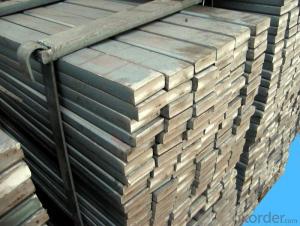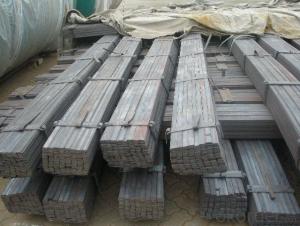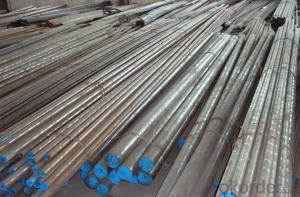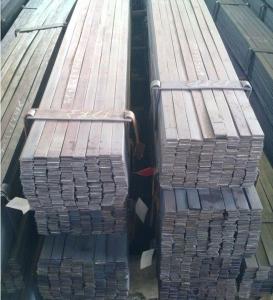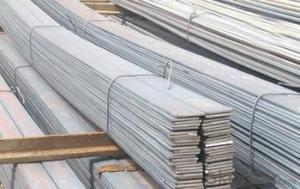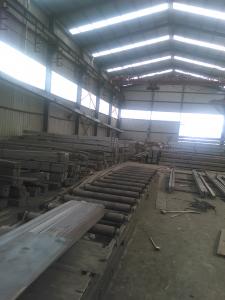Hot Rolled Steel Flat Bars A36, SS400, Q235
- Loading Port:
- Shanghai
- Payment Terms:
- TT OR LC
- Min Order Qty:
- 25 m.t.
- Supply Capability:
- 200000 m.t./month
OKorder Service Pledge
OKorder Financial Service
You Might Also Like
Specification
Product Description:
OKorder is offering Hot Rolled Steel Flat Bars A36, SS400, Q235 at great prices with worldwide shipping. Our supplier is a world-class manufacturer of steel, with our products utilized the world over. OKorder annually supplies products to European, North American and Asian markets. We provide quotations within 24 hours of receiving an inquiry and guarantee competitive prices.
Product Applications:
Hot Rolled Steel Flat Bars A36, SS400, Q235 are ideal for structural applications and are widely used in the construction of buildings and bridges, and the manufacturing, petrochemical, and transportation industries.
Product Advantages:
OKorder's Hot Rolled Steel Flat Bars A36, SS400, Q235 are durable, strong, and resist corrosion.
Main Product Features:
· Premium quality
· Prompt delivery & seaworthy packing (30 days after receiving deposit)
· Corrosion resistance
· Can be recycled and reused
· Mill test certification
· Professional Service
· Competitive pricing
Product Specifications:
Manufacture: Hot Rolled Steel Flat Bars A36, SS400, Q235
Grade: Q195 – 235
Certificates: ISO, SGS, BV, CIQ
Length: 6m – 12m, as per customer request
Packaging: Export packing, nude packing, bundled
Chemical composition of Q235
Alloy No | Grade | Element(%) | ||||
C
| Mn
| S
| P
| Si
| ||
Q235
|
B
|
0.12—0.20 |
0.3—0.7 |
≤0.045 |
≤0.045
|
≤0.3
|
Physical properties of Q235
Alloy No | Grade | Yielding strength point(Mpa) | Tensile strength (Mpa) | Elongation after fracture(%) | ||||||
Thickness (mm) | Thickness (mm) | |||||||||
≤16 | >16--40 | >40--60 | >60--100 | ≤16 | >16--40 | >40--60 | >60--100 | |||
≥ | ≥ | |||||||||
Q235 |
B |
235 |
225 |
215 |
205 |
375--500 |
26 |
25 |
24 |
23 |
FAQ:
Q1: Why buy Hot Rolled Steel Flat Bars A36, SS400, Q235 from OKorder.com?
A1: All products offered byOKorder.com are carefully selected from China's most reliable manufacturing enterprises. Through its ISO certifications, OKorder.com adheres to the highest standards and a commitment to supply chain safety and customer satisfaction.
Q2: What is the normal tolerance of Hot Rolled Steel Flat Bars A36, SS400, Q235?
A2: Normally 3%-5%, but we can also produce the goods according to the customers' requests.
Q3: How soon can we receive the product after purchase?
A3: Within three days of placing an order, we will begin production. The specific shipping date is dependent upon international and government factors, but is typically 7 to 10 workdays

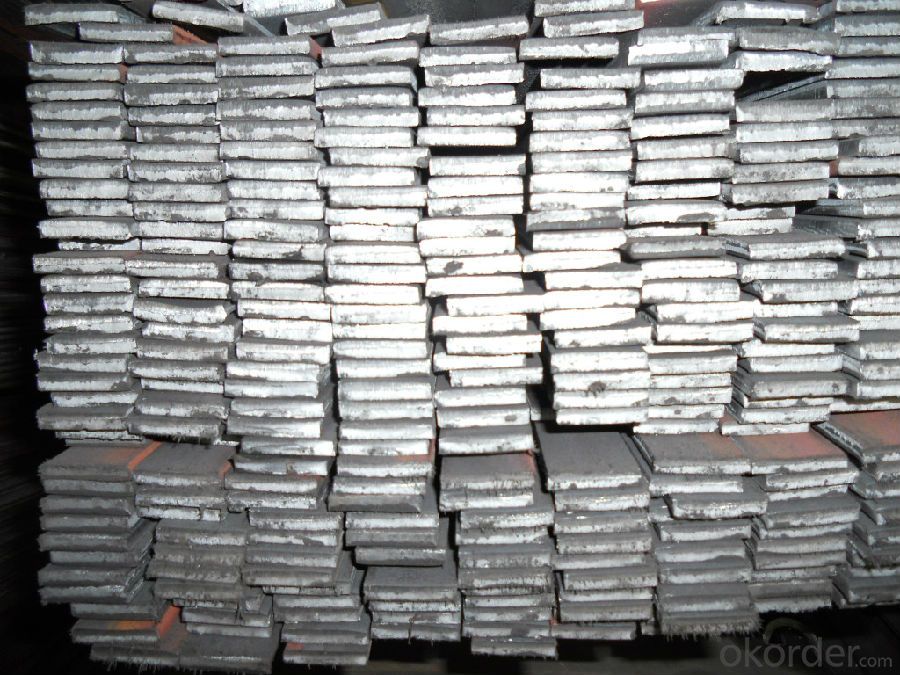
- Q: What are the standard lengths of steel flat bars?
- The standard lengths of steel flat bars can vary depending on the manufacturer and the specific requirements of the project. However, there are commonly available standard lengths that are widely used in the industry. These standard lengths typically range from 6 feet to 20 feet. Some manufacturers may also offer longer lengths, such as 24 feet or even custom lengths, but these are less commonly used. It is important to note that steel flat bars can also be cut and customized to specific lengths based on the needs of the project.
- Q: Can steel flat bars be used for manufacturing marine equipment or structures?
- Yes, steel flat bars can be used for manufacturing marine equipment or structures. Steel is known for its high strength and durability, making it suitable for withstanding the harsh conditions of the marine environment. Additionally, steel flat bars can be easily shaped and welded, allowing for the construction of various marine equipment and structures such as ship hulls, boat frames, and offshore platforms.
- Q: How do steel flat bars compare to copper flat bars?
- Steel flat bars are generally stronger and more durable than copper flat bars. Steel has a higher tensile strength and is less prone to bending or warping under heavy loads. Additionally, steel is more resistant to corrosion and can withstand harsh environmental conditions better than copper. However, copper flat bars have superior electrical conductivity and are often preferred for electrical and plumbing applications. Ultimately, the choice between steel and copper flat bars depends on the specific requirements and intended use of the material.
- Q: Can steel flat bars be painted?
- Yes, steel flat bars can be painted. The steel surface needs to be properly cleaned and prepared before applying a primer and paint. This ensures good adhesion and a long-lasting finish.
- Q: How are steel flat bars measured?
- Steel flat bars are typically measured by their width and thickness. The width refers to the horizontal dimension of the bar, while the thickness refers to the vertical dimension. Both measurements are usually expressed in millimeters or inches. For example, a steel flat bar might be specified as 50 mm wide and 5 mm thick. These measurements help to determine the overall size and shape of the bar, allowing it to be accurately used in construction, manufacturing, or other applications.
- Q: What are the different types of edge finishes available for steel flat bars?
- Steel flat bars can have various edge finishes to meet different aesthetic and functional needs. Here are some of the most common options: 1. Square Edge: The edges of the flat bars are kept square, making it a simple and basic finish. It is often used for structural purposes or when appearance is not a significant factor. 2. Rounded Edge: Also referred to as a radius edge, this finish involves smoothing out the sharp edges of the flat bar. It enhances visual appeal and safety by reducing the risk of injuries from sharp edges. 3. Beveled Edge: This finish involves cutting the edges of the flat bar at a specific angle, usually 45 degrees. It is commonly used when joining two flat bars at a specific angle to create a clean and precise joint. 4. Rolled Edge: This type of finish requires rolling the edges of the flat bar to create a curved or rolled appearance. Rolled edges are often used for decorative purposes, adding a unique and stylish touch to the flat bar. 5. Serrated Edge: A serrated edge finish features small notches or teeth along the edges of the flat bar. It is commonly used in applications where enhanced grip or traction is necessary, such as grating or flooring. 6. Chamfered Edge: Instead of only beveling the ends, chamfering involves cutting a beveled edge along the entire length of the flat bar. This finish is frequently used to remove sharp corners and make handling the flat bar easier. These examples showcase the variety of edge finishes available for steel flat bars. The choice of finish depends on factors such as the intended use, aesthetic preferences, safety requirements, and cost considerations.
- Q: Are steel flat bars suitable for fabrication of frames or structures?
- Yes, steel flat bars are commonly used in the fabrication of frames or structures due to their high strength, durability, and versatility. They provide excellent support and stability, making them suitable for various applications in construction, manufacturing, and engineering industries.
- Q: How do steel flat bars contribute to the overall aesthetics of a design?
- There are multiple ways in which steel flat bars can enhance the overall aesthetics of a design. Firstly, their sleek and clean lines have the ability to add a modern and contemporary touch to any design. The straight edges and sharp corners of steel flat bars create a sense of precision and order, resulting in a polished and sophisticated appearance. Moreover, steel flat bars offer endless design possibilities due to their malleability. They can be easily manipulated into various shapes and forms, allowing designers to create intricate patterns, unique textures, or even sculptural elements. This versatility enables steel flat bars to be incorporated into a wide range of projects, including furniture, architectural features, decorative accents, and art installations. Furthermore, steel flat bars possess a shiny and reflective surface, which enhances the visual appeal of a design. The polished finish of steel has the ability to catch and reflect light, adding an elegant and bright touch to the overall aesthetic. This reflective quality can also create captivating visual effects, such as mirroring or interacting with the surrounding environment. Lastly, the strength and durability of steel flat bars contribute to the longevity and resilience of a design. The solid and robust nature of steel conveys a sense of stability and reliability, making the design appear solid and well-built. This perception of strength has a positive influence on the overall aesthetic, as it communicates a sense of quality and craftsmanship. In conclusion, steel flat bars enhance the overall aesthetics of a design through their sleek lines, versatile forms, reflective surfaces, and perception of strength. Their modern appearance, design flexibility, and durability make them a favored choice among designers who aim to create visually appealing and long-lasting designs.
- Q: What are the different types of tests performed on steel flat bars?
- Steel flat bars undergo several common tests to ensure their quality and suitability for different uses. These tests evaluate the strength, durability, and other mechanical properties of the steel. Some of the tests conducted on steel flat bars include: 1. Tensile Test: This test determines the maximum amount of tensile stress the steel flat bar can withstand before it breaks. It provides information about the material's yield strength, ultimate tensile strength, and elongation. 2. Hardness Test: Assessing the hardness of a steel flat bar is crucial in determining its resistance to deformation, wear, and abrasion. Methods such as Rockwell, Brinell, and Vickers hardness tests are employed to measure the bar's hardness. 3. Impact Test: This test evaluates the steel flat bar's ability to absorb energy under high-stress conditions. By striking the material with a pendulum, the test measures the energy absorbed and the bar's resistance to cracking or breaking. 4. Bend Test: The bend test examines the steel flat bar's ductility and flexibility by bending it to a specific angle without fracturing. This test helps determine if the material is suitable for applications involving bending or forming processes. 5. Chemical Analysis: Chemical analysis is conducted to determine the composition of the steel flat bar, including the percentages of various elements like carbon, manganese, silicon, and others. This analysis ensures that the steel meets the required specifications and standards. 6. Ultrasonic Testing: Ultrasonic testing employs high-frequency sound waves to detect internal flaws or defects in the steel flat bar. It helps identify cracks, voids, or inclusions that might impact the overall integrity and strength of the material. 7. Dimensional Inspection: This test ensures that the steel flat bar meets the necessary dimensional tolerances and specifications. It involves measuring the bar's length, width, thickness, and other dimensions to ensure compliance with desired standards. 8. Microstructure Analysis: Microstructure analysis involves examining the metallurgical structure of the steel flat bar under a microscope. It aids in identifying the grain size, phase distribution, and any irregularities that may affect the material's mechanical properties. By conducting these tests, manufacturers, suppliers, and end-users can ensure that steel flat bars meet required quality standards and are suitable for their intended applications.
- Q: 80 * 80 * 4 galvanized flat steel is what specifications?
- Galvanized square pipe.Specification: 80 * 80 * 4 is the dimension of galvanized square pipe. That is to say, the length and width of the inner diameter of the nozzle are 80mm, and the thickness of the tube wall is 4mm.
Send your message to us
Hot Rolled Steel Flat Bars A36, SS400, Q235
- Loading Port:
- Shanghai
- Payment Terms:
- TT OR LC
- Min Order Qty:
- 25 m.t.
- Supply Capability:
- 200000 m.t./month
OKorder Service Pledge
OKorder Financial Service
Similar products
Hot products
Hot Searches
Related keywords












